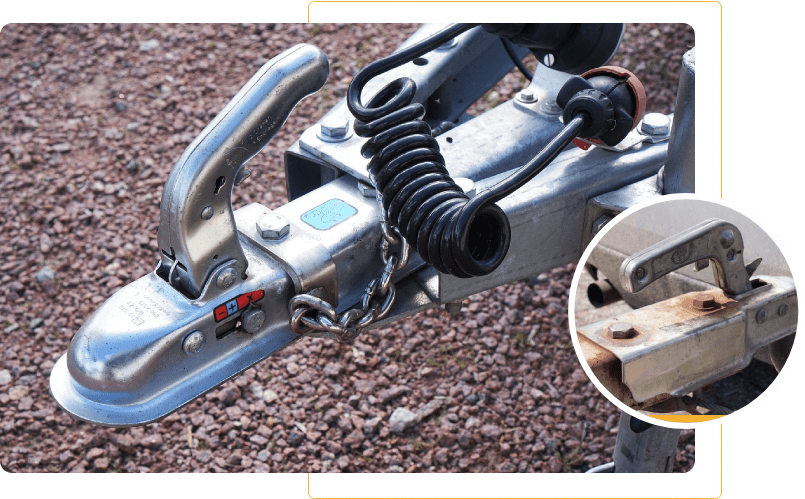Info & Terms

The Hitch is the mechanism that is typically mounted to the rear of a vehicle under the bumper. There are five classes of Hitches for towing trailers. Each class is designed for a specific trailer weight range. When selecting the appropriate hitch, make sure the weight rating of the hitch is greater than the loaded weight of the trailer that will be towed. The tow vehicle capacity for weight carrying and hitch attachment will vary and will sometimes dictate the class of hitch that can be used. As you will see below, under each class, always consult your owner's manual for vehicle rating.
Class I
Class I hitches are weight-carrying (WC) hitches rated up to 2000 lbs. gross trailer weight (GTW) with a maximum trailer tongue weight (TW) of 200 lbs. This style of hitch typically uses a 1-1/4" square receiver opening. The use of a draw bar and hitch ball of the same rating or higher is required. Some hitches in this class may attach to the vehicle bumper or trunk pan. Most other Class I hitches attach to the vehicle frame. Always consult your owner's manual for vehicle rating.
Class II
Class II hitches are weight-carrying (WC) hitches rated up to 3500 lbs. gross trailer weight (GTW) with a maximum trailer tongue weight (TW) of 300 lbs. This style of hitch typically uses a 1-1/4" square receiver opening. The use of a draw bar and hitch ball of the same rating or higher is required. Class II hitches normally attach to the vehicle frame and or bumper. Always consult your owner's manual for vehicle rating.
Class III
Class III hitches are weight-carrying (WC) and also are weight distributing (WD) hitches, depending on the vehicle and hitch specifications. Not all Class III hitches are rated to be both. The hitch specifications will alert you to a hitch that is not weight-distributing. Class III hitches used as weight carrying are rated up to 5000 lbs. gross trailer weight (GTW) with a maximum trailer tongue weight (TW) of 500 lbs. Hitches that are used for weight distribution are rated up to 10,000 lbs. gross trailer weight (GTW) with a maximum trailer tongue weight (TW) of 1000 lbs. This style of hitch typically uses a 2" square receiver opening. The use of a ball mount and hitch ball of the same rating or higher is required. To use the weight distribution side of the hitch, a weight distribution system is required. Class III hitches attach to the vehicle frame only. Always consult your owner's manual for vehicle rating.
Class IV
Class IV hitches are very similar to Class III hitches except for the weight ratings. Class IV hitches are weight-carrying (WC) and weight-distributing (WD) hitches, depending on the vehicle and hitch specifications. Not all Class IV hitches are rated to be both. The hitch specifications will alert you to a hitch that is not weight-distributing. Class IV hitches used for weight carrying are rated up to 12,000 lbs. gross trailer weight (GTW) with a maximum trailer tongue weight (TW) of 1200 lbs. Hitches that are used for weight distribution are rated up to 15,000 lbs. gross trailer weight (GTW) with a maximum trailer tongue weight (TW) of 1500 lbs. This style of hitch typically uses a 2" square receiver opening. The use of a ball mount and hitch ball of the same rating or higher is required for weight carrying. To use the weight distribution side of the hitch, a weight distribution system is required. Class IV hitches attach to the vehicle frame only. Always consult your owner's manual for vehicle rating.
Class V
Class V hitches are very similar to Class III & IV hitches except for the weight ratings. This style of hitch uses a 2-1/2" square receiver opening. Class V hitches are weight-carrying (WC) and weight-distributing (WD) hitches. Class V hitches used for weight carrying are rated up to 13,000 lbs. gross trailer weight (GTW) with a maximum trailer tongue weight (TW) of 1300 lbs. Hitches that are used for weight distribution are rated up to 17,000 lbs. gross trailer weight (GTW) with a maximum trailer tongue weight (TW) of 1700 lbs. The use of a ball mount and hitch ball of the same rating or higher is required. To use the weight distribution side of the hitch, a weight distribution system is required. Class V hitches attach to the vehicle frame only. Always consult your owner's manual for vehicle rating.